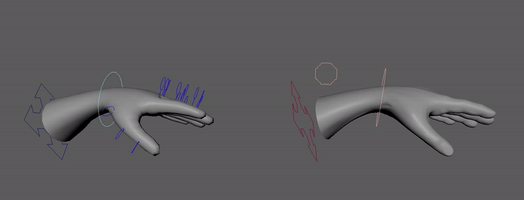Simplifying Animation With Complex Rigs:
Multi-Rig Pipeline Research
Node-based Connections | Viewport-only Interface | Switch Between Two Rigs
Abstract:
This research project tests the practical implementation of an alternative rigging pipeline for 3D animated characters, which will provide an animator with a detailed end result while simplifying the control system. The creative product will be a 3D model of a human hand that can swap between a simplified and a complex rig, allowing animators to place keys on the simple rig and achieve the intricate deformation fidelity of the complex one. To achieve the desired efficiency during animation, an interactive overlay will be constructed within the scene that will act as a user interface. The process will be explored in Autodesk Maya, mainly focusing on the Node Editor to achieve the connections. The transitive nature of this creative product means that rigging artists can use this adapted methodology to have flexibility in terms of creating the level of detail desired. Alongside this, they can work in tandem with animators by utilizing the simple ‘parent’ rig and multiple complex ‘children’ rigs to swap out the necessary components for desired scenes without sacrificing any workflow consistency.
Presented at
UCF Student Scholar Symposium,
March 2024
Work In Progress:
As of now, the focus of the research has been connection of two hand rigs within the node editor. One is simple, with low-poly geometry, and utilizing a minimal forward-kinematic joint system: each joint down the chain determines the position of the next. This simple structure is denoted with blue controllers. The second hand, with more complex geometry, uses set driven keys,. This is an association between the numericals -10 to 10 to determine the position of the joints.
Going forward, the application of a camera-based HUD will allow an override of the described connection, for more flexibility in positioning the final result to achieve a desired pose.
Project Inspiration and Goals:
From an animation standpoint, user-interface is just as important as the technical abilities of a given rig. If an animator cannot effectively and efficiently use specified tools, they will be less likely to integrate them into their work. A complicated or frustrating control process can be detrimental to a fundamentally stable rig. Animating on a simplistic rig that will have influence over a complex rig will allow users to focus on important base animation that will translate into the more complex at their own discretion, cleaning up the interface as desired. This research will provide an understanding of how to utilize a link between a very complex and intricate rig with a high level of detail, and a simple, user-friendly rig for animation purposes.
Metaphorically, this will simplify the interface between an animator and the rig, similar to an automatic transmission for a car driver and their vehicle.
Methods Pictured:
One-to-one connections are made to parts of each rig that function identically, like the move and wrist controllers (left).
For example, the thumb connections control two attributes, the Curl and Spread, based on the rotation values of the thumb controller. To make these values more accurately match the -10 to 10 range of the set driven keys, the ‘multiply Divide’ node is used with 0.1 on the Z axis for Curl, and 0.25 on the X for Spread (shown below).






